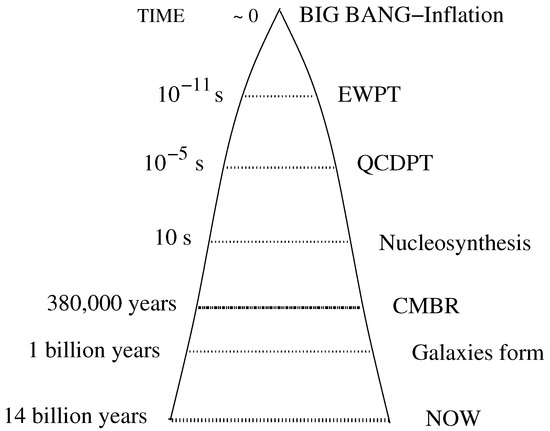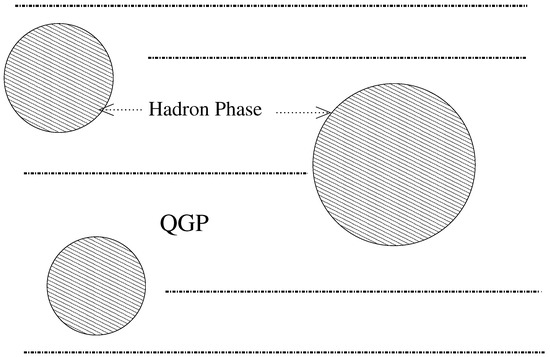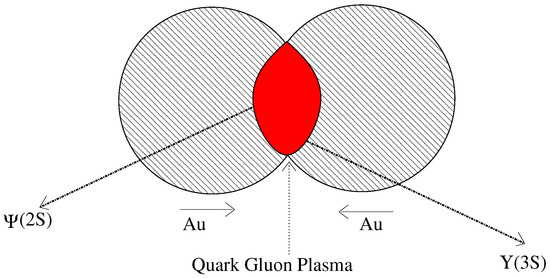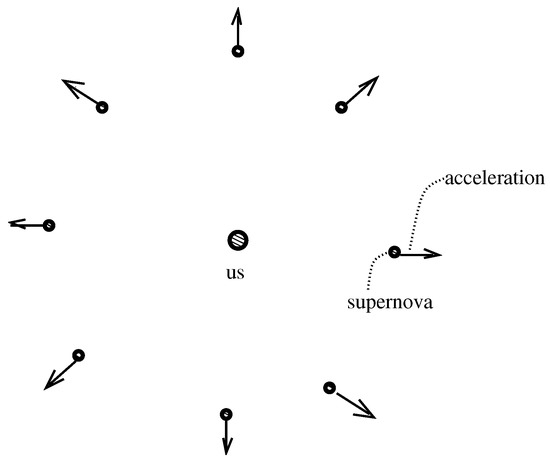Abstract
This is an editorial on low energy nuclear astrophysics and sterile neutrinos as dark matter. First, the symmetric cosmic microwave background radiation and the the symmetric evolution of the Universe are editorialized. Then, low energy astrophysics with the evolution of the Sun, supernovae, and the Galaxy’s rotation are editorialized. In the final section, sterile neutrinos as dark matter is editorialized.
1. Introduction
In Section 2, the cosmic microwave background radiation (CMBR), from which the percent of dark matter, dark energy, and normal matter is estimated, is editorialized. Only about 4% of the Universe is normal matter. A remarkable result from the CMBR is that dark energy, which is anti-gravity and therefore repels rather than attracts, is approximately 70% of the Universe.
In Section 2.1, the evolution of the Universe is editorialized and the timings of various astronomical events are described. The evolution of the Universe began with the Big Bang about 14 billion years ago, with inflation caused by anti-gravity dark energy (about 70% of the universe). This and various astronomical phase transitions, such as the EWPT ( s) and QCDPT ( s), where s is seconds, are editorialized.
In Section 3, low energy nuclear astrophysics is editorialized.
In Section 4.1 on the evolution of the Sun, detailing how is produced starting with – reactions. Other nuclear reactions can produce an atomic nuclei as large as .
In Section 4.2 on supernovae and dark energy, the acceleration of distant supernovae results in an estimate of the amount dark energy in the Universe, which is consistent with the CMBR estimate.
In Section 4.3, the Milky Way Galaxy rotation estimate of dark matter in the Universe is editorialized. As with dark energy, an estimation of 24% for the amount dark matter in the Universe is consistent with the CMBR estimate.
In Section 5, sterile neutrinos as dark matter is described. Neutrino oscillations [1,2] are editorialized, with the active neutrino oscillating to the active neutrino . The possibility that a third sterile neutrino, , could be most of dark matter is editorialized.
Section 6 is Conclusions.
2. Cosmic Microwave Background Radiation (CMBR)
There have been many CMBR experiments, such as those in refs. [3,4,5,6], which have estimated the total density of the present universe, dark matter density, dark energy density, etc.
is the density of the Universe, with for a flat universe. The recent results from CMBR observations [7] are:
Therefore, about 27% of the Universe is dark matter.
About 70% of the Universe is dark energy, which is anti-gravity. Dark energy (quintessence) produced inflation at a very early time, which is why we now have an almost homogeneous universe.
Only about 4% of the Universe is normal matter.
2.1. The Evolution of the Universe
The Universe has been evolving for about 13.7 billion years. It has gone from a very dense universe with a very high temperature to our present universe, as illustrated in Figure 1.

Figure 1.
Evolution of the Universe.
Inflation and dark energy occurred after about s. The electroweak phase transition (EWPT) [7] occurred at about s after the Big Bang, when the temperature was T≃ 125 GeV. During the EWPT, it is believed that all particles (except the photon) got their mass. The QCD phase transition (QCDPT) occurred at s at 150 MeV, when mesons consisting of quarks and antiquarks bound via gluon exchange were created.
3. The QCDPT and Possible Detection of the QGP
The critical temperature for the QCDPT, , was ≃ 150 MeV and bubbles of our universe nucleated within the QGP, as shown in Figure 2.

Figure 2.
Hadron phase forming within the QGP during the QCDPT.
A main goal of the study of heavy quark state production in Au–Au collisions is the detection of the quark gluon plasma. As Figure 3 below illustrates, the emission of mixed hybrid mesons ( and ), with active gluons could be a signal of the formation of the QGP.

Figure 3.
Au–Au collisions producing and from the QGP.
4. Editorial of Low Energy Nuclear Astrophysics
We begin this section with a subsection on nuclear energy and the evolution of the Sun followed by subsections on supernovae and dark energy and galaxy rotation and dark matter.
4.1. Nuclear Energy and the Evolution of the Sun
About 5 billion years ago, our Sun was a cloud of dust. Gravity collapsed the material in on itself as it began to spin. Small particles drew together into larger particles, bound by the force of gravity, and about 4.6 billion years ago our Sun was formed.
Nuclear energy produces outward pressure, stopping the gravitational collapse of the Sun. Nuclear energy starts with proton–proton reactions. In the below, , and are protons, deuterium, and helium, respectively.
These nuclear reactions are followed by helium fusion:
In approximately 5 billion years, our aging Sun will develop a core and envelope that do not burn. A hydrogen shell will develop that will burn and expand our aging sun into a red giant. This red giant will be so large that it will cover Earth.
4.2. Supernovae and Dark Energy
Some massive stars collapse and explode, emitting bright light. They are called supernovae.
By measuring the redshift of light from known atoms, about one century ago, Hubble determined that the Universe is expanding. The velocity of supernovae has been measured at various distances using redshifts of light from supernovae.
The Supernova Cosmology Project [8] has carried out many measurements of redshifts of light from supernovae, with redshifts between 0.18 and 0.83. This is illustrated in Figure 4.

Figure 4.
Measurements of acceleration of supernovae to determine redshifts and dark energy density in the Universe.
Note that in Figure 4, the arrows on the supernovae point away from “us”, which indicates that the speed of the supernovae is increasing. Thus, the matter between “us” and the supernovae is anti-gravity, as stated in Section 2.
Furthermore, as stated in Section 2.1, “Inflation and dark energy occurred at about s”, called the Big Bang. As verified be CMBR measurements, the largest amount of matter in the Universe is dark energy. At about s, the Universe is inflating, which is consistent with the largest amount of matter in the Universe being anti-gravity matter, otherwise known as dark energy.
From the results in ref. [8] and other studies of supernovae redshifts, it was determined that the dark energy density (vacuum energy) is , in agreement with CMBR measurements.
4.3. Galaxy Rotation and Dark Matter
Our galaxy, the Milky Way, is a gargantuan collection of stars, gas, and dust, with a massive black hole held together by gravity. Gravity does not collapse due to the centripetal force.
By measuring the galaxy’s radius, its speed, and the amount of visible mass, the amount of dark matter mass can be estimated. This is illustrated in Figure 5 below.

Figure 5.
Measured Milky Way galaxy radius, velocity, and visible mass.
From the measurements illustrated in the figure above, it is estimated that about 24% of the Milky Way galaxy’s mass is dark matter, including the mass of the massive black hole at the enter of the galaxy. This is consistent with the CMBR estimate of dark matter.
5. Sterile Neutrinos as Dark Matter
Sterile neutrinos are a well-known source of dark matter. For many years, the MiniBooNE Collaboration has studied neutrino oscillations. Using oscillations, the MiniBooNE Collaboration [1,2] detected a sterile neutrino, , and estimated the mass difference between this sterile neutrino and a standard neutrino as:
which is too small for sterile neutrino to be a WIMP (weakly interacting massive particle).
The notation for the three active neutrinos, , and and the three sterile neutrinos is , and .
where neutrinos with flavors and three sterile neutrinos, are related to neutrinos with a definite mass by
where U is a 6 × 6 matrix. In ref. [9], the sterile–active neutrino mixing angles were calculated, which should be useful for future searches for sterile neutrinos as dark matter particles.
Recently, the MiniBooNE Collaboration has carried out a search for sub-Gev dark matter at the Fermilab [10], with the estimate
Therefore, one can conclude that it is likely that most of the dark matter in the Universe consists of sterile neutrinos.
6. Conclusions
In the first section after the Introduction, the Cosmic Microwave Background Radiation (CMBR) was editorialized. From the CMBR estimates, about 70% of the Universe is dark energy, 27% is dark matter, and only 4% is normal matter.
The third section editorialized the QCDPT and possible detection of the Quark Gluon Plasma (QGP).
The fourth section has three subsections.
In Section 4.1, the evolution of the Sun is editorialized.
In Section 4.2, the use of the acceleration of supernovae to estimate the amount of dark energy in the Universe is editorialized.
In the last Section 4.3, an estimate of the amount of dark matter in the Universe was estimated by the rotation of our own Milky Way Galaxy, with the estimate consistent with the CMBR estimate.
In the fifth (last) section, sterile neutrinos were editorialized. The mass of the third sterile neutrino is large enough that most of the dark matter, estimated from CMBR to be about 27% of total matter in the Universe, might be sterile neutrinos.
Institutional Review Board Statement
Not applicable.
Informed Consent Statement
Not applicable.
Data Availability Statement
Not applicable.
Acknowledgments
Author L.S.K. acknowledges support in part as a visitor at Los Alamos National Laboratory and William Louis, LANL Group P-25, for information on the (2021) MiniBooNE Collaboration results on sterile neutrinos.
Conflicts of Interest
The authors declare no conflict of interest.
References
- Aguilar-Arevalo, A.A.; MiniBooNE Collaboration. Improved Search for ν¯μ→ν¯e Oscillations in the MiniBooNE Experiment. Phys. Rev. Lett. 2013, 110, 161801. [Google Scholar] [CrossRef] [PubMed]
- Aguilar-Arevalo, A.A.; MiniBooNE Collaboration. Dark matter search in nucleon, pion, and electron channels from a proton beam dump with MiniBooNE. Phys. Rev. D 2018, 8, 112004. [Google Scholar] [CrossRef]
- Fixsen, D.J.; Cheng, E.S.; Gales, J.M.; Mather, J.C.; Shafer, R.A.; Wright, E.L. The Cosmic Microwave Background Spectrum from the Full COBE FIRAS Data Set. Astrophys. J. 1996, 473, 576. [Google Scholar] [CrossRef]
- Reichardt, C.L.; Ade, P.A.; Bock, J.J.; Bond, J.R.; Brevik, J.A.; Contaldi, C.R.; Daub, M.D.; Dempsey, J.T.; Goldstein, J.H.; Holzapfel, W.L.; et al. High resolution CMB power spectrum from the complete ACBAR data set (ACBAR). Astrophys. J. 2008, 674, 1200. [Google Scholar] [CrossRef]
- Gupta, S.; Ade, P.; Bock, J.; Bowden, M.; Brown, M.L.; Cahill, G.; Castro, P.G.; Church, S.; Culverhouse, T.; Friedman, R.B.; et al. Parameter estimation from improved measurements of the cosmic microwave background from QUaD. Astrophys. J. 2010, 716, 1040. [Google Scholar] [CrossRef]
- Hinshaw, G.; Larson, D.; Komatsu, E.; Spergel, D.N.; Bennett, C.; Dunkley, J.; Nolta, M.R.; Halpern, M.; Hill, R.S.; Odegard, N.; et al. Nine-year Wilkinson Microwave Anisotropy Probe (WMAP) observations: Cosmological parameter results. arXiv 2013, arXiv:1212.5226. [Google Scholar] [CrossRef]
- Calabrese, E.; Hložek, R.A.; Bond, J.R.; Devlin, M.J.; Dunkley, J.; Halpern, M.; Hincks, A.D.; Irwin, K.D.; Kosowsky, A.; Moodley, K.; et al. Cosmological parameters from pre-Planck CMB measurements: A 2017 update. Phys. Rev. D. 2017, 95, 063525. [Google Scholar] [CrossRef]
- Perlmutter, S.; Aldering, G.; Goldhaber, G.; Knop, R.A.; Nugent, P.; Castro, P.G.; Deustua, S.; Fabbro, S.; Goobar, A.; Groom, D.E.; et al. Measurements of Ω and Λ from 42 High-Redshift Supernovae (The Supernova Cosmology Project). Astrophys. J. 1999, 517, 565. [Google Scholar] [CrossRef]
- Kisslinger, L.S. Neutrino Oscillations with Three Active and Three Sterile Neutrinos. Int. J. Theor. Phys. 2016, 55, 3274–3279. [Google Scholar] [CrossRef]
- Aguilar-Arevalo, A.A.; Brown, B.C.; Conrad, J.M.; Dharmapalan, R.; Diaz, A.; Djurcic, Z.; Finley, D.A.; Ford, R.; Garvey, G.T.; Gollapinni, S.; et al. Updated MiniBooNE neutrino oscillation results with increased data and new background studies. Phys. Rev. D 2021, 103, 052002. [Google Scholar] [CrossRef]
Disclaimer/Publisher’s Note: The statements, opinions and data contained in all publications are solely those of the individual author(s) and contributor(s) and not of MDPI and/or the editor(s). MDPI and/or the editor(s) disclaim responsibility for any injury to people or property resulting from any ideas, methods, instructions or products referred to in the content. |
© 2023 by the author. Licensee MDPI, Basel, Switzerland. This article is an open access article distributed under the terms and conditions of the Creative Commons Attribution (CC BY) license (https://creativecommons.org/licenses/by/4.0/).